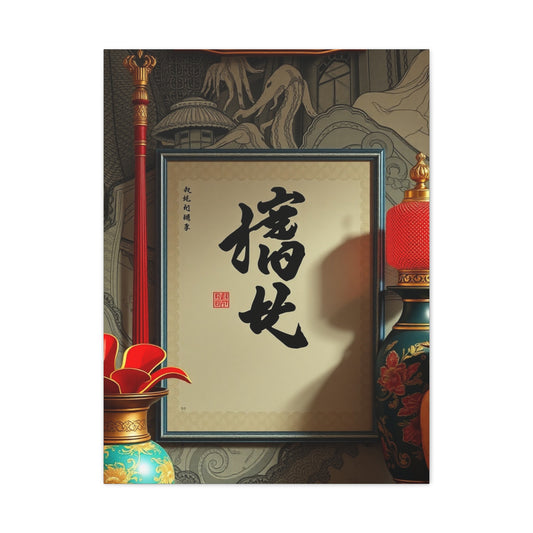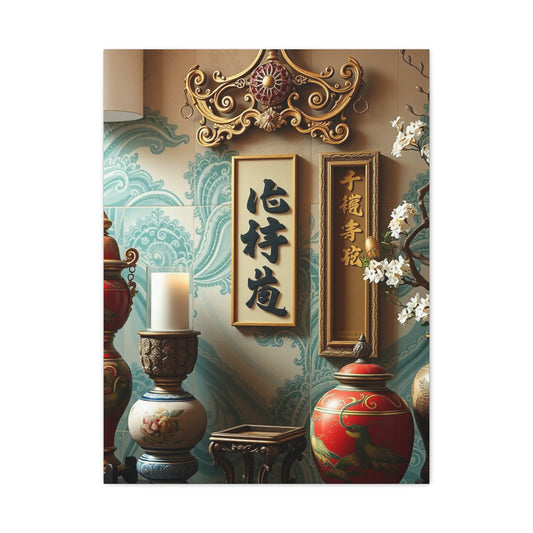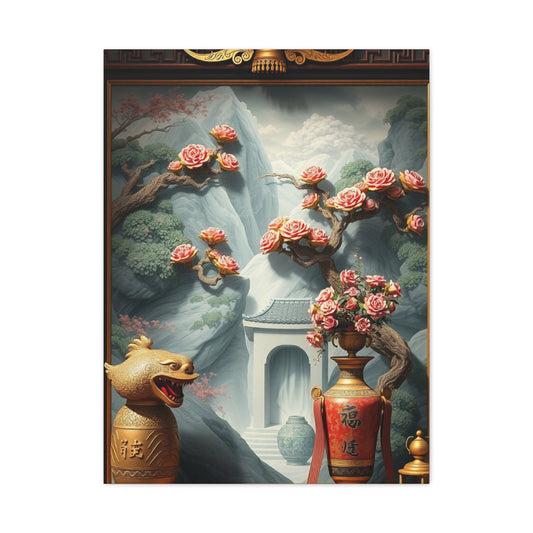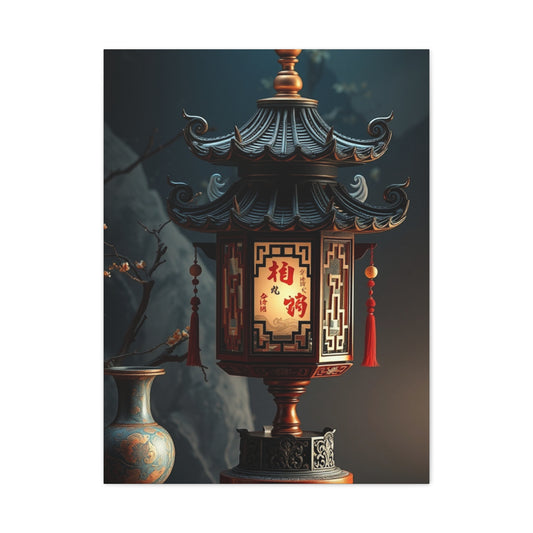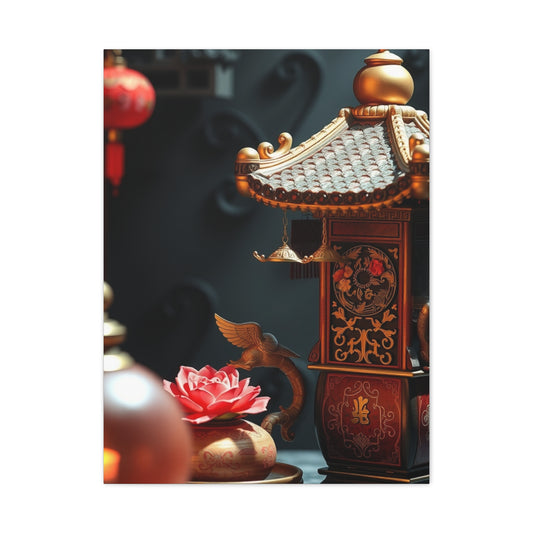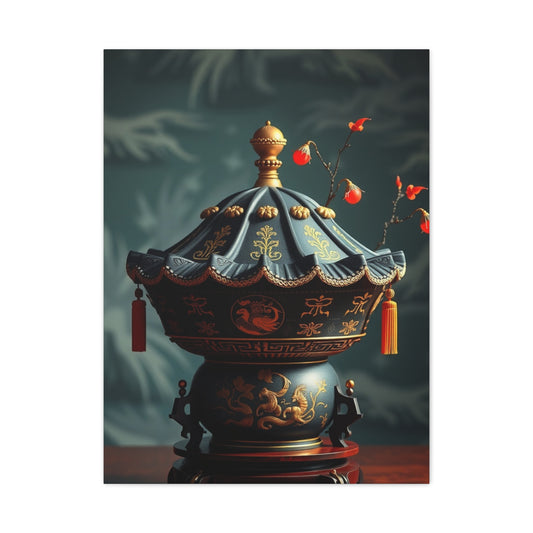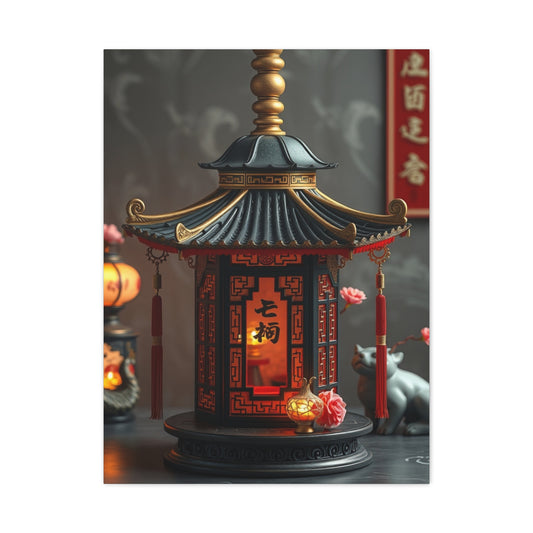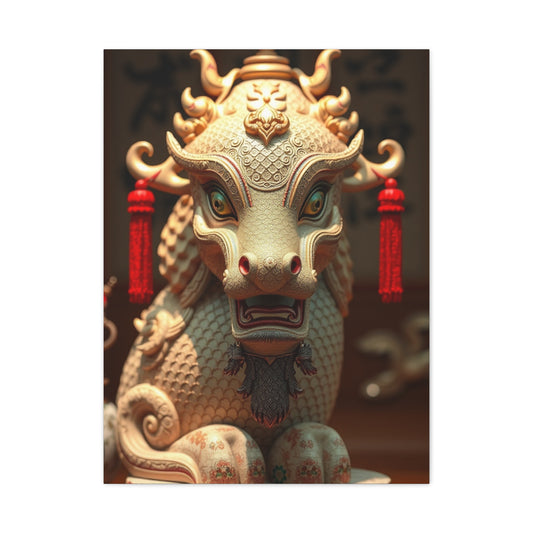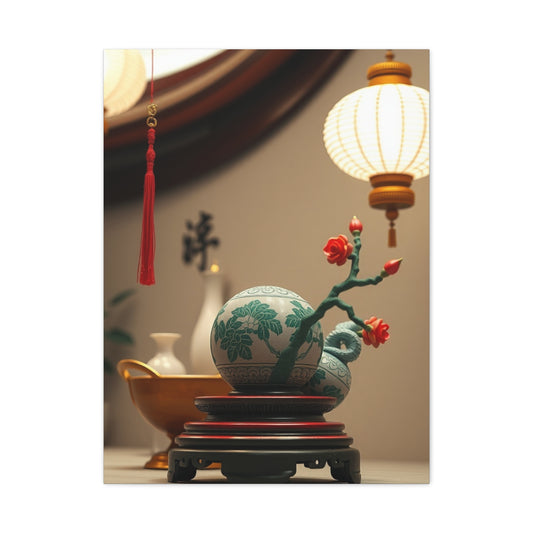Elegant Chinese Wall Art: Timeless Oriental Designs to Refine Your Home Décor
Transforming your living environment with Chinese wall art represents one of the most profound ways to infuse cultural sophistication and visual harmony into your home. The ancient traditions of Chinese artistic expression offer an extraordinary palette of design possibilities that transcend mere decoration, creating spaces that resonate with philosophical depth, aesthetic refinement, and spiritual tranquility. This comprehensive guide will unveil the secrets of incorporating authentic Chinese wall decor elements that will metamorphose your interiors into sanctuaries of elegance and cultural appreciation.
The journey of understanding Chinese wall art begins with recognizing its fundamental role in creating spaces that nurture both the eye and the soul. Unlike conventional Western decorating approaches, Chinese artistic traditions emphasize the harmonious balance between form, function, and spiritual significance. Every brushstroke, every carefully chosen color, and every symbolic element carries centuries of cultural wisdom and artistic mastery.
Mastering Thematic Selection for Authentic Chinese Wall Displays
The foundation of exceptional Chinese wall decor lies in understanding the profound thematic traditions that have shaped Chinese artistic expression for millennia. Each theme carries distinct symbolic meanings and aesthetic qualities that can dramatically influence the energy and atmosphere of your space. The art of selecting appropriate themes requires careful consideration of both personal preferences and the deeper cultural significance embedded within each artistic tradition.
Landscape paintings, known as shanshui in Chinese tradition, represent the pinnacle of Chinese artistic achievement. These magnificent works capture the essence of natural harmony through masterful depictions of mountains, rivers, clouds, and forests. The philosophical underpinnings of landscape art emphasize the relationship between humanity and nature, encouraging contemplation and inner peace. When selecting landscape pieces for your walls, consider works that feature misty mountain ranges emerging from cloud formations, serene lake reflections capturing ancient pavilions, or rushing waterfalls cascading through rocky gorges.
Botanical themes hold equally significant positions in Chinese artistic traditions. The celebrated "Four Gentlemen" - plum blossoms, orchids, chrysanthemums, and bamboo - each represent distinct virtues and seasonal celebrations. Plum blossoms symbolize perseverance and hope, blooming courageously in winter's harsh conditions. Orchids embody refinement and nobility, their delicate beauty representing scholarly pursuit and moral integrity. Chrysanthemums celebrate longevity and autumn's golden abundance, while bamboo demonstrates flexibility, strength, and unwavering principles.
Bird and animal motifs provide another rich thematic category for Chinese wall decor. The magnificent dragon, supreme among Chinese mythological creatures, represents imperial power, wisdom, and auspicious fortune. Phoenix imagery symbolizes rebirth, feminine grace, and harmonious relationships. Cranes signify longevity and spiritual transcendence, often depicted soaring above mountainous landscapes or standing gracefully beside tranquil waters. Tigers embody courage and protection, while fish, particularly koi, represent abundance and perseverance.
Calligraphic art forms constitute perhaps the most intellectually sophisticated category of Chinese wall decor. These works combine linguistic meaning with visual artistry, transforming written characters into flowing, dynamic compositions. Classical poetry verses, philosophical maxims, and auspicious phrases rendered in various calligraphic styles can add profound depth to your decor. The rhythmic flow of brush strokes across silk or paper creates visual music that speaks to both the rational mind and emotional spirit.
Historical and mythological narratives provide opportunities to display complex, multi-figure compositions that tell complete stories through visual imagery. These works often feature legendary heroes, celestial beings, or significant historical events rendered with meticulous attention to detail and symbolic accuracy. Such pieces serve as conversation starters while demonstrating appreciation for Chinese cultural heritage and storytelling traditions.
Embracing Textural Richness in Chinese Wall Art Presentations
The tactile dimension of Chinese wall decor extends far beyond simple visual appeal, incorporating sophisticated textural elements that engage multiple senses and create immersive aesthetic experiences. Traditional Chinese artisans have long understood that texture contributes significantly to the overall impact and emotional resonance of artistic presentations. Modern interpretations of these classical approaches offer numerous opportunities to enhance your walls with compelling textural variations.
Silk, revered as one of China's most precious cultural exports, provides an unparalleled medium for wall art presentations. Hand-painted silk scrolls offer luminous color saturation and subtle surface variations that change dramatically under different lighting conditions. The natural sheen of silk creates depth and movement within painted compositions, causing images to appear almost alive as viewers move through the space. Embroidered silk panels introduce additional textural complexity through raised thread work that creates fascinating shadow patterns and three-dimensional effects.
Handmade paper, particularly traditional varieties crafted from mulberry bark, bamboo fibers, or rice stalks, provides another avenue for textural exploration. These papers possess unique surface characteristics - subtle irregularities, organic fiber patterns, and varying thickness - that contribute to the authentic feel of traditional Chinese artwork. Mounted scrolls utilizing these papers create compelling visual contrasts between smooth painted areas and textured paper surfaces.
Carved wooden elements represent one of the most dramatically textural approaches to Chinese wall decor. Intricate relief carvings featuring traditional motifs such as flowering branches, mythological creatures, or geometric patterns create stunning three-dimensional focal points. These pieces cast ever-changing shadow patterns throughout the day, ensuring that your decor remains visually dynamic from morning until evening. Lacquered wood surfaces add glossy reflective qualities that amplify surrounding colors and create sophisticated interplays between matte and shiny textures.
Metal work, particularly pieces incorporating bronze, brass, or copper elements, introduces industrial textures that complement softer organic materials. Traditional Chinese metalwork often features raised designs, patinated surfaces, and deliberate oxidation effects that create rich visual depth. These elements work particularly well in contemporary settings where the contrast between ancient craftsmanship and modern architectural elements creates compelling design tensions.
Fabric appliqué techniques allow for the incorporation of multiple textile textures within single compositions. Traditional Chinese textile arts include sophisticated layering methods that combine silk, cotton, linen, and metallic threads to create complex surface variations. These techniques can be adapted for modern wall presentations through carefully curated collections that showcase different weaving patterns, dyeing methods, and decorative stitching styles.
Stone and ceramic elements provide opportunities to introduce geological textures that ground Chinese wall decor in natural materials. Carved stone tablets featuring calligraphic inscriptions, ceramic tile work displaying traditional patterns, or mounted jade pieces create tactile contrasts that invite closer inspection while maintaining visual coherence with painted and textile elements.
Orchestrating Dynamic Gallery Wall Compositions
Creating compelling gallery wall arrangements requires sophisticated understanding of visual composition principles, spatial relationships, and the unique characteristics of Chinese artistic traditions. Unlike random collections of artwork, thoughtfully orchestrated gallery walls tell cohesive stories while maintaining visual balance and emotional resonance. The key to success lies in treating the entire wall as a single, complex composition rather than a collection of individual pieces.
Begin your gallery wall planning by establishing a central anchor piece - typically the largest or most visually commanding work in your collection. This anchor establishes the overall tone, color palette, and thematic direction for the entire arrangement. Traditional Chinese landscape scrolls, large calligraphy pieces, or dramatic bird-and-flower compositions often serve effectively as anchor elements. Position this piece at eye level, typically 57-60 inches from the floor to the center of the artwork.
Surrounding your anchor piece, arrange secondary works that complement rather than compete with the central focus. These supporting pieces might include smaller paintings in related themes, coordinating calligraphy fragments, or decorative objects that echo the primary work's color scheme. Maintain visual flow between pieces through careful attention to color relationships, compositional directions, and thematic connections.
Scale variation creates visual interest and prevents monotonous arrangements. Combine large statement pieces with medium-sized works and small accent pieces to establish rhythmic patterns across your wall space. However, avoid extreme size disparities that might create uncomfortable visual tensions or make smaller pieces appear insignificant beside oversized neighbors.
Spacing between individual pieces requires careful calibration to maintain both unity and individual identity within the overall composition. Generally, maintain 2-3 inches between frames for closely related pieces, increasing to 4-6 inches when transitioning between different themes or styles. Larger gaps can create intentional pauses that allow viewers to appreciate individual works before moving to the next section.
Consider the directional flow of individual compositions when arranging multiple pieces. Chinese paintings often feature strong directional elements - rivers flowing toward specific directions, birds in flight following particular paths, or calligraphy characters arranged in vertical columns. Arrange pieces so these directional forces complement rather than conflict with each other, creating overall movement patterns that guide viewers' eyes smoothly across the entire wall.
Frame selection plays a crucial role in unifying disparate pieces while maintaining individual character. Traditional Chinese artwork often benefits from simple, elegant frames that don't compete with the artwork itself. Consider using consistent frame styles with subtle variations in width or finish to create visual continuity while allowing for some individual expression. Alternatively, contrast traditional artwork with contemporary frames for modern eclectic approaches.
Lighting design significantly impacts gallery wall effectiveness. Install adjustable track lighting or picture lights that can be positioned to highlight individual pieces without creating harsh shadows or glare. Soft, warm lighting typically enhances the subtle color variations found in traditional Chinese pigments while creating intimate viewing atmospheres appropriate for contemplative artwork.
Strategic Color Harmonies in Chinese Interior Aesthetics
Color selection in Chinese wall decor extends far beyond simple aesthetic preference, encompassing complex systems of symbolic meaning, emotional psychology, and harmonious balance that have evolved over thousands of years. Understanding these traditional color relationships enables you to create interior environments that not only please the eye but also promote positive energy flow and emotional well-being according to classical Chinese philosophical principles.
Red occupies a position of supreme importance in Chinese color symbolism, representing good fortune, joy, celebration, and protective power. However, the application of red in interior spaces requires sophisticated understanding of its various shades and appropriate contexts. Deep crimson works effectively as accent colors in formal spaces, while softer coral and rose tones can create warmth without overwhelming smaller rooms. Vermillion red, historically reserved for imperial use, adds dramatic sophistication to dining rooms and entryways where its bold presence welcomes guests and stimulates conversation.
Gold represents prosperity, imperial dignity, and spiritual illumination in Chinese tradition. Incorporate golden tones through frame selections, accent details, or artwork featuring gold leaf applications. Metallic gold additions create luminous focal points that reflect and amplify surrounding light sources, making spaces appear larger and more luxurious. Subtle gold threading in textile wall hangings or delicate gold ink details in calligraphy pieces provide elegant refinement without ostentious display.
Green symbolizes growth, harmony, and natural balance, making it an ideal choice for creating tranquil environments conducive to relaxation and contemplation. Jade green holds particular significance, representing purity and moral integrity while connecting interior spaces to the natural world. Incorporate various green tones through landscape paintings featuring lush forests, bamboo grove depictions, or mineral green pigments used in traditional Chinese paintings.
Blue, particularly the deep cobalt blue found in traditional Chinese ceramics, represents depth, stability, and scholarly wisdom. Incorporate blue elements through porcelain artwork, indigo-dyed textiles, or paintings featuring vast sky expanses and deep water reflections. Lighter blue tones can create sense of spaciousness in smaller rooms while maintaining connection to traditional Chinese aesthetic principles.
Black and white combinations create sophisticated monochromatic schemes that allow for subtle color accents while maintaining visual elegance. Traditional Chinese ink paintings demonstrate masterful use of tonal variations within limited color palettes, creating depth and interest through brushwork technique rather than color variety. These approaches work particularly well in contemporary settings where minimalist aesthetics meet traditional artistic expression.
Purple, historically associated with spirituality and higher consciousness, provides opportunities for creating meditative environments. Deep eggplant tones combined with gold accents create rich, contemplative atmospheres suitable for study areas or private retreat spaces. Lavender and lighter purple shades offer gentler alternatives that promote relaxation without the intensity of deeper tones.
Understanding color temperature relationships helps create cohesive interior environments that feel naturally balanced. Warm colors - reds, golds, warm greens - tend to advance visually and create intimate, cozy atmospheres. Cool colors - blues, cool greens, purples - recede visually and can make spaces appear larger while promoting calm, contemplative moods. Balancing warm and cool elements throughout your Chinese wall decor creates dynamic yet harmonious environments.
Consider the impact of natural and artificial lighting on your chosen color palette. Chinese pigments often feature subtle complexity that reveals different characteristics under various lighting conditions. Morning sunlight might emphasize warm undertones in paintings, while evening lamplight could bring out cooler blue and green elements. Plan your color selections with these lighting variations in mind to ensure consistent beauty throughout different times of day.
Achieving Perfect Proportional Balance and Scale Mastery
The principles of scale and proportion in Chinese wall decor draw from ancient mathematical relationships and aesthetic theories that create naturally pleasing visual arrangements. Understanding these fundamental concepts enables you to select and position artwork that feels inherently balanced and harmonious, regardless of room size or architectural constraints.
The Golden Ratio, approximately 1.618:1, appears frequently in Chinese art and provides an excellent guideline for artwork sizing and placement decisions. When selecting pieces for prominent wall locations, consider works whose height-to-width ratios approximate this classical proportion. Similarly, the relationship between artwork size and wall dimensions should follow pleasing mathematical relationships rather than arbitrary placement decisions.
Vertical scroll paintings, traditional formats in Chinese artistic expression, work particularly well in rooms with high ceilings where their elongated proportions complement architectural verticality. These pieces draw the eye upward, creating sense of grandeur and spiritual elevation while making rooms appear larger and more spacious. Position vertical scrolls to take advantage of natural sight lines and traffic flow patterns within your space.
Horizontal compositions, including landscape handscrolls and wide-format paintings, work effectively above furniture pieces such as sofas, credenzas, or dining room sideboards. The horizontal emphasis creates visual stability and grounds furniture arrangements while providing expansive viewing experiences that encourage contemplation and visual exploration.
Multiple small pieces arranged in geometric patterns can create impact equal to single large works while offering greater flexibility in arrangement and rearrangement. Consider creating grid patterns with uniform spacing, or experiment with asymmetrical arrangements that maintain visual balance through careful attention to visual weight distribution.
Visual weight encompasses not only physical size but also color intensity, compositional complexity, and symbolic significance. A small but intensely colored piece might balance a larger work rendered in subtle tones. Similarly, highly detailed compositions can hold visual attention equal to much larger, simpler pieces. Understanding these relationships allows for sophisticated arrangements that feel naturally balanced despite apparent size disparities.
Consider the viewing distance when selecting appropriate scales for your artwork. Pieces intended for close viewing - such as detailed calligraphy or miniature paintings - can be smaller and positioned where viewers can approach them comfortably. Artwork designed for viewing from across the room should be proportionally larger and feature bold, easily readable compositions that maintain impact at greater distances.
Architectural elements within your space influence appropriate scale selections. Rooms with elaborate molding, coffered ceilings, or other decorative architectural details require artwork substantial enough to hold its own against these competing elements. Conversely, simple, clean-lined spaces can accommodate more delicate artwork that might be overwhelmed in busier architectural contexts.
Furniture scale relationships require careful consideration when positioning wall decor. Artwork should relate proportionally to the furniture beneath it - typically ranging from one-half to three-quarters of the furniture width. This creates pleasing visual connections between horizontal and vertical elements while avoiding situations where artwork appears to float disconnected from room furnishings.
Consider seasonal adjustments to your wall arrangements. Lighter, more delicate pieces might feel appropriate during spring and summer months, while richer, more substantial works could provide comforting weight during autumn and winter seasons. This approach allows your wall decor to evolve with changing natural rhythms while maintaining year-round visual interest.
Sophisticated Framing and Presentation Methods
The presentation of Chinese wall art requires careful consideration of framing methods, mounting techniques, and display approaches that honor the artwork's cultural origins while adapting to contemporary interior environments. Traditional Chinese presentation methods offer time-tested approaches that enhance artwork's impact while ensuring proper preservation and respectful display.
Traditional Chinese scrolls, whether silk or paper-based, benefit from specialized mounting techniques that preserve their original character while making them suitable for permanent wall display. Museum-quality mounting involves carefully stretching the artwork onto archival backing boards using pH-neutral adhesives and conservation-grade materials. This process requires professional expertise but ensures long-term preservation while creating elegant, unframed presentations that emphasize the artwork's inherent beauty.
Frame selection for Chinese artwork requires balancing traditional authenticity with contemporary interior design requirements. Simple, elegant frames in natural wood finishes complement most Chinese art styles without competing for visual attention. Bamboo frames provide authentic Chinese character while offering lightweight, sustainable framing solutions. Dark wood frames in ebony or walnut create sophisticated presentations that work well in formal interior settings.
Matting considerations play crucial roles in Chinese artwork presentation. Traditional Chinese art often features empty space that contributes significantly to compositional balance and contemplative viewing experiences. Wide mats in neutral colors - cream, off-white, or subtle warm gray - provide breathing room around artwork while creating clean, uncluttered presentations. Silk-covered mats add textural interest and cultural authenticity to formal presentations.
Glass selection impacts both artwork preservation and viewing experience. Museum-quality conservation glass provides UV protection while minimizing reflective glare that can interfere with artwork appreciation. Anti-reflective coatings ensure optimal viewing from multiple angles while protecting delicate pigments from light damage. For extremely valuable or fragile pieces, consider Plexiglas alternatives that provide protection without the weight and breakage risks of traditional glass.
Lighting integration requires specialized approaches for Chinese artwork that often features subtle color variations and delicate brushwork details. LED picture lights with adjustable color temperature settings allow for optimal illumination that enhances rather than overwhelms the artwork. Avoid direct lighting that creates harsh shadows or hot spots that could damage sensitive materials over time.
Multiple piece arrangements require consistent presentation approaches that unify individual works while maintaining their distinct characters. Consider using identical frame styles with subtle variations in size to accommodate different artwork dimensions. Alternatively, vary frame treatments systematically - perhaps alternating between natural wood and painted finishes - to create rhythmic visual patterns across wall arrangements.
Hanging hardware selection ensures secure, level installation while minimizing visible mounting elements. Professional-grade hanging systems distribute weight evenly and allow for precise positioning adjustments. Consider museum-style hanging tracks for arrangements that might require periodic repositioning or seasonal changes.
Protective considerations become particularly important for valuable or irreplaceable Chinese artwork. Install security systems appropriate for your collection value, and consider environmental controls that maintain stable temperature and humidity levels. Document your collection with detailed photographs and maintain insurance coverage appropriate for replacement values.
Illuminating Chinese Art Through Strategic Lighting Design
Proper lighting design transforms Chinese wall art from static decorative elements into dynamic, living components of your interior environment. The interplay between light and traditional Chinese artistic materials creates constantly changing visual experiences that enhance both individual artwork appreciation and overall ambient atmosphere.
Natural lighting considerations begin with understanding how traditional Chinese pigments and materials respond to different light qualities throughout the day. Morning light with its cool, clear characteristics brings out subtle details in ink paintings and emphasizes the natural texture of silk and paper surfaces. Afternoon light, warmer and more golden, enhances red and gold pigments while creating dramatic shadow patterns from three-dimensional elements.
Directional natural light can be controlled and modified through window treatments that filter and diffuse harsh sunlight while preserving beneficial illumination. Sheer curtains or bamboo screens provide culturally appropriate light filtration while maintaining the connection to natural lighting rhythms that Chinese art was designed to complement.
Artificial lighting systems should complement rather than replace natural illumination, providing consistent viewing conditions during evening hours while highlighting specific artwork characteristics that might not be apparent under natural light alone. Track lighting systems offer flexibility for highlighting multiple pieces while allowing for seasonal rearrangements and collection changes.
Color temperature selection significantly impacts how Chinese artwork appears under artificial illumination. Warm white light (2700-3000K) enhances traditional warm pigments and creates intimate viewing atmospheres appropriate for contemplative art appreciation. Cool white light (4000-5000K) provides more accurate color rendering for detailed viewing and study of brushwork techniques and subtle color variations.
Accent lighting techniques can create dramatic focal points within Chinese art displays while maintaining overall ambient comfort. Carefully positioned spotlights can emphasize texture in carved elements, create depth in layered compositions, or highlight specific details within complex multi-figure paintings. However, avoid over-dramatic lighting that might appear theatrical rather than respectful of the artwork's contemplative nature.
Indirect lighting approaches create gentle, even illumination that reduces harsh shadows while providing adequate light for comfortable viewing. Cove lighting, uplighting, and wall-washing techniques create soft, diffused illumination that enhances wall-mounted art without creating glare or hot spots that could cause viewing discomfort or material damage over time.
Dimming controls allow for lighting adjustment that accommodates different viewing needs and times of day. Bright settings facilitate detailed examination of brushwork and calligraphy, while dimmer settings create contemplative atmospheres suitable for meditation and relaxation. Programmable dimming systems can automatically adjust lighting levels throughout the day to complement natural light patterns.
Seasonal lighting adjustments help maintain optimal viewing conditions as natural light patterns change throughout the year. Winter lighting might require brighter settings to compensate for reduced daylight hours, while summer adjustments might focus on controlling heat from lighting fixtures that could affect delicate artwork materials.
Integrating Chinese Wall Art with Contemporary Interior Styles
Successfully incorporating Chinese wall art into contemporary interior environments requires sophisticated understanding of design principles that allow traditional artwork to enhance rather than conflict with modern architectural elements and furnishing styles. The key lies in finding common ground between ancient aesthetic principles and contemporary design sensibilities.
Minimalist contemporary interiors provide ideal backdrops for Chinese art, as both traditions emphasize simplicity, balance, and the beauty of empty space. Clean, uncluttered wall surfaces allow Chinese paintings and calligraphy to command attention without competing against busy decorative elements. The minimalist principle of "less is more" aligns perfectly with traditional Chinese aesthetic philosophy that values restraint and subtle sophistication over ostentatious display.
Industrial contemporary styles, characterized by exposed architectural elements, raw materials, and neutral color palettes, can be softened and humanized through the introduction of Chinese artwork. The contrast between hard industrial surfaces and delicate artistic expression creates compelling design tensions that make both elements more visually interesting. Traditional Chinese silk paintings provide textural and color contrast against concrete, steel, and glass surfaces.
Mid-century modern furnishings and Chinese art share common design DNA, as both traditions emphasize clean lines, natural materials, and harmonious proportions. The warm wood tones common in mid-century furniture complement traditional Chinese art frames and carved elements. Additionally, the period's appreciation for Asian design influence creates natural affinity between furniture styles and traditional Chinese artistic expression.
Scandinavian design principles - simplicity, functionality, and connection to nature - align closely with Chinese aesthetic philosophy. Light Nordic color palettes provide neutral backdrops that allow Chinese art to provide color and cultural richness without overwhelming the space's inherent serenity. Natural wood elements common in Scandinavian interiors complement traditional Chinese art presentations.
Eclectic contemporary approaches offer maximum flexibility for incorporating Chinese wall art alongside diverse furnishing styles and decorative elements. The key to successful eclectic integration lies in establishing unifying elements - perhaps a consistent color palette, repeated materials, or common scale relationships - that tie disparate pieces together into cohesive visual narratives.
Transitional style interiors, blending traditional and contemporary elements, provide natural homes for Chinese art that bridges cultural and temporal boundaries. These environments often feature neutral backgrounds with selective color and pattern introductions, creating perfect opportunities for Chinese artwork to provide focal points and cultural depth.
Color bridging techniques help integrate Chinese art with existing interior color schemes that might not initially seem compatible. Identify colors within your chosen artwork that appear elsewhere in your room - perhaps in upholstery, rugs, or accessory pieces - and emphasize these connections through strategic accent placement and repetition.
Scale integration requires careful attention to ensuring Chinese artwork relates appropriately to contemporary furniture proportions and room dimensions. Modern furniture often features lower profiles than traditional pieces, which might require adjusting artwork hanging heights or selecting pieces with horizontal emphasis that complement contemporary furniture lines.
Material harmony creates connections between traditional Chinese art materials and contemporary interior finishes. Natural wood frames might echo hardwood flooring or furniture finishes, while metal accent details in artwork could connect to contemporary light fixtures or hardware elements throughout the space.
Curating Authentic Chinese Art Collections
Building a meaningful collection of Chinese wall art requires developing expertise in authentication, quality assessment, and cultural understanding that enables you to make informed purchasing decisions while avoiding common pitfalls that plague novice collectors. The journey toward developing a sophisticated collection involves education, patience, and gradually refined appreciation for artistic excellence and cultural authenticity.
Understanding artistic periods and regional styles provides foundation knowledge for making intelligent collecting decisions. Chinese art history spans thousands of years, with distinct characteristics marking different dynasties, geographical regions, and cultural movements. Familiarize yourself with major periods - Tang, Song, Ming, and Qing dynasties each produced distinctive artistic styles that continue to influence contemporary work.
Authentication challenges require developing relationships with reputable dealers, auction houses, and experts who can provide reliable attribution information. Original antique pieces command premium prices and require careful documentation, while high-quality contemporary works by established artists offer more accessible entry points for beginning collectors. Reproduction pieces can provide affordable alternatives for decorative purposes, provided they are clearly identified and priced appropriately.
Quality assessment skills develop through exposure to museum collections, gallery exhibitions, and scholarly publications that illustrate examples of superior artistic achievement. Learn to recognize signs of quality in brushwork, composition, color application, and overall artistic vision that distinguish exceptional pieces from merely decorative works.
Cultural authenticity encompasses both artistic technique and subject matter accuracy. Authentic Chinese art reflects genuine understanding of cultural symbols, philosophical concepts, and artistic traditions rather than superficial copying of visual elements. Study the meanings behind common motifs, color choices, and compositional approaches to develop appreciation for cultural depth beyond surface decoration.
Budget planning requires realistic assessment of market prices and long-term collecting goals. Establish clear priorities regarding whether you prefer original antique pieces, contemporary works by established artists, or high-quality reproductions for decorative purposes. Each category offers distinct advantages and limitations that should align with your collecting objectives and financial resources.
Conservation considerations become increasingly important as collections grow in value and personal significance. Original artwork requires proper environmental controls, professional framing, and periodic conservation assessment to ensure long-term preservation. Factor these ongoing costs into your collecting budget and establish relationships with qualified conservation professionals.
Documentation and insurance needs grow alongside collection value and complexity. Maintain detailed records of provenance, purchase information, and condition reports for valuable pieces. Professional appraisals may be necessary for insurance purposes and estate planning, particularly for original antique works or contemporary pieces by recognized artists.
Display rotation strategies allow you to enjoy larger collections within limited wall space while providing rest periods for delicate pieces that benefit from reduced light exposure. Plan storage solutions that provide proper protection for artwork not currently displayed, and consider seasonal rotation schedules that keep your displayed collection fresh and interesting.
Market awareness helps guide intelligent purchasing decisions and timing. Follow auction results, gallery prices, and market trends for artists and periods that interest you. Understanding market dynamics enables you to recognize good values while avoiding inflated prices during speculation periods.
Building expertise requires ongoing education through books, exhibitions, lectures, and conversations with other collectors and experts. Join collector groups, attend museum programs, and participate in cultural organizations that provide access to knowledge and networking opportunities within the Chinese art community.
Seasonal Adaptation and Rotation Strategies
The traditional Chinese appreciation for seasonal change and natural rhythms offers opportunities to create dynamic wall displays that evolve throughout the year, maintaining visual interest while honoring cultural traditions that celebrate the cyclical nature of time and seasonal transformation. This approach transforms static wall arrangements into living, breathing components of your interior environment that respond to natural patterns and cultural celebrations.
Spring arrangements might emphasize renewal, growth, and emerging life through artwork featuring blooming flowers, young animals, or landscape scenes depicting the awakening natural world. Plum blossoms, among the first flowers to bloom, symbolize courage and hope as they appear while winter still grips the landscape. Cherry blossoms represent the fleeting beauty of life and the importance of appreciating present moments. Fresh green tones in bamboo paintings or early spring landscape scenes create visual connections to the season's energy of renewal and growth.
Summer displays can celebrate abundance, maturity, and the full expression of natural energy through bold, vibrant compositions. Lotus flowers, blooming in summer's heat, represent purity and spiritual enlightenment rising from muddy waters. Lush landscape scenes featuring full foliage, flowing rivers, and abundant wildlife capture summer's generous energy. Bird paintings depicting species in their full breeding plumage add color and vitality to summer wall arrangements.
Autumn presentations honor harvest, reflection, and the golden beauty of maturity through artwork that captures the season's contemplative spirit. Chrysanthemums, traditional autumn flowers in Chinese culture, represent longevity and the wisdom that comes with age. Landscape paintings featuring golden and red foliage, misty mountains, and serene lakes encourage the introspective mood appropriate to autumn's energy. Calligraphy pieces featuring poetry about harvest, gratitude, or seasonal change add intellectual depth to autumn displays.
Winter arrangements emphasize endurance, inner strength, and the beauty found in simplicity and restraint. Snow scenes, bare branches, and monochromatic ink paintings capture winter's austere elegance while encouraging contemplation and inner reflection. Bamboo paintings, showing the plant's ability to bend without breaking under snow's weight, inspire resilience during challenging times. Pine and plum compositions celebrate plants that thrive during winter's harsh conditions.
Festival and celebration rotations allow your wall displays to participate in traditional Chinese cultural observances throughout the year. Chinese New Year presents opportunities to display auspicious symbols, bright red colors, and artwork featuring dragons, phoenixes, and other symbols of good fortune. Mid-Autumn Festival celebrations might feature moon imagery, harvest themes, and family gathering scenes. Other traditional festivals offer additional opportunities for thematic displays that connect your home to broader cultural rhythms.
Storage solutions for rotated artwork require careful planning to ensure proper protection during dormant periods. Acid-free storage boxes, proper humidity control, and protection from light exposure help preserve artwork quality during storage. Create inventory systems that track rotation schedules and storage locations, making it easy to locate specific pieces when needed for seasonal changes.
Transition planning helps ensure smooth changes between seasonal displays without leaving walls bare or disrupting room aesthetics. Plan overlap periods where outgoing and incoming pieces coexist temporarily, allowing for gradual rather than abrupt changes. This approach maintains visual continuity while accommodating the practical aspects of artwork removal, cleaning, and reinstallation.
Documentation of seasonal arrangements through photography helps track successful combinations and provides reference material for future rotations. Note which pieces work well together, optimal lighting conditions, and visitor reactions to different seasonal presentations. This information guides future rotation decisions and helps refine your seasonal display strategies over time.
Climate considerations affect rotation timing and storage requirements. High humidity periods might require additional moisture protection for paper-based artwork, while extremely dry conditions could affect silk-mounted pieces. Monitor environmental conditions and adjust rotation schedules to protect artwork during periods of extreme weather conditions.
Maintenance scheduling coordinates with seasonal rotations to ensure optimal artwork condition year-round. Plan professional cleaning, frame adjustments, and conservation assessments to coincide with seasonal changes when artwork is already being handled and relocated. This efficient approach minimizes handling while ensuring consistent maintenance attention.
Maintenance and Preservation of Chinese Wall Art
Proper care and preservation of Chinese wall art requires understanding traditional materials, environmental sensitivities, and appropriate maintenance techniques that protect these cultural treasures while ensuring their continued beauty and longevity. The investment in proper preservation techniques pays dividends through maintained appearance, prevented deterioration, and preserved cultural and monetary value.
Environmental control represents the most critical aspect of artwork preservation, as Chinese traditional materials - silk, paper, natural pigments, and organic inks - respond sensitively to temperature, humidity, and light exposure variations. Maintain stable temperature ranges between 68-72°F with relative humidity levels of 45-55%. Sudden environmental changes cause expansion and contraction cycles that can damage delicate materials over time.
Light exposure management protects artwork from the cumulative damage caused by ultraviolet radiation and excessive illumination. Traditional Chinese pigments, particularly organic colorants derived from plant and mineral sources, fade gradually under continuous light exposure. Rotate displayed pieces periodically to allow recovery periods, and use UV-filtering glazing in frames to minimize harmful radiation while maintaining viewing quality.
Dust removal requires gentle techniques appropriate for delicate surfaces and traditional mounting methods. Use soft-bristled brushes or museum-quality vacuum attachments with adjustable suction to remove accumulated dust without applying pressure to artwork surfaces. Avoid chemical cleaning products that could interact negatively with traditional adhesives, pigments, or mounting materials.
Frame inspection schedules help identify potential problems before they cause artwork damage. Check hanging hardware for corrosion or loosening, examine frame joints for separation, and inspect glazing for condensation or seal failures. Address identified problems promptly to prevent progressive damage that becomes more expensive to repair over time.
Professional conservation assessment provides expert evaluation of artwork condition and recommended preservation strategies. Establish relationships with qualified conservators who specialize in Asian art and traditional materials. Schedule periodic assessments based on artwork age, value, and observed condition changes to ensure appropriate preventive measures.
Handling protocols minimize damage during movement, cleaning, or storage activities. Always handle artwork with clean hands or cotton gloves, support pieces adequately during transport, and avoid touching painted or inked surfaces. Train family members and household staff in appropriate handling techniques to prevent accidental damage during routine cleaning or maintenance activities.
Insurance documentation requires detailed condition reports, professional appraisals, and regular value updates to ensure adequate coverage. Photograph artwork periodically to document condition changes over time, and maintain detailed records of provenance, purchase information, and conservation treatments. This documentation proves invaluable for insurance claims and estate planning purposes.
Pest prevention protects organic materials from insect damage that can devastate paper and silk artwork. Monitor for signs of insect activity, maintain clean environments that discourage pest establishment, and consider professional pest control consultation for valuable collections. Early detection prevents extensive damage that might require expensive conservation treatment.
Storage preparation for pieces not currently displayed requires specialized materials and techniques that prevent deterioration during dormant periods. Use acid-free boxes and tissue paper, maintain stable environmental conditions in storage areas, and inspect stored pieces periodically for condition changes. Proper storage extends artwork life while protecting investment value.
Emergency planning prepares for natural disasters, theft, or other catastrophic events that could threaten your collection. Develop evacuation priorities, maintain current photographs and documentation in secure locations, and consider security systems appropriate for collection value. Prevention and preparation minimize losses during emergency situations.
Conclusion
The art of incorporating Chinese wall decor into contemporary living spaces represents far more than mere aesthetic enhancement - it constitutes a meaningful dialogue between ancient wisdom and modern lifestyle aspirations. Through careful selection, thoughtful presentation, and respectful integration, Chinese artwork transforms ordinary interiors into sophisticated environments that nurture both visual appreciation and spiritual contemplation.
The journey of creating meaningful Chinese wall art displays requires patience, education, and gradual development of aesthetic sensibilities that appreciate both artistic excellence and cultural authenticity. As your understanding deepens, you'll discover that each piece of artwork carries within it centuries of cultural wisdom, artistic innovation, and philosophical insight that enriches daily life through silent but profound presence.
Whether you choose to focus on traditional landscape paintings that capture the eternal beauty of natural harmony, calligraphic works that transform written language into visual poetry, or contemporary interpretations that bridge cultural boundaries, your Chinese wall art collection becomes a personal statement of appreciation for one of humanity's greatest artistic traditions. The careful attention to themes, textures, compositions, colors, proportions, and presentations discussed throughout this guide provides the foundation for creating displays that honor both artistic excellence and cultural heritage.
The seasonal rotation strategies, maintenance protocols, and preservation techniques outlined here ensure that your investment in Chinese wall art continues to provide pleasure and inspiration for years to come. As you develop expertise in selection, authentication, and care, your collection becomes not only a source of daily aesthetic pleasure but also a valuable cultural asset that can be passed to future generations.

